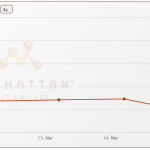 Gold is more than just an economic store of value – it is also a critical component in millions of consumer electronic devices. Because of the metal’s electrical conductivity, ductility, resistance to corrosion, and lack of toxicity, it’s applied as a thin layer on electrical contacts to guarantee reliable and long lasting functionality.
Gold is more than just an economic store of value – it is also a critical component in millions of consumer electronic devices. Because of the metal’s electrical conductivity, ductility, resistance to corrosion, and lack of toxicity, it’s applied as a thin layer on electrical contacts to guarantee reliable and long lasting functionality.
But even though gold is the go-to material for creating electronics of the highest quality, that old adage “too much of a good thing” still holds true. This was famously demonstrated by the Titan supercomputer just a few years ago.
Developed and built by Cray Inc., the Titan made a splash in 2011 when it was officially recognized as the fastest supercomputer in the world with the capability of performing 17.59 quadrillion operations per second. The Oak Ridge National Laboratory (ORNL) planned to use the Titan’s incredible power to perform calculations for materials research, nuclear energy research, climate modeling, and other analysis techniques. But before officially putting the supercomputer to work, ORNL ran a series of acceptance tests – which uncovered a design flaw that kept the Titan from meeting stability requirements. ORNL discovered that the Titan’s stability issues caused by electrical connector pins were soldered using too much gold.
In microelectronic applications (like supercomputer connector pins), gold must be applied carefully to prevent the development of intermetallics. The design for the Titan’s connector pins used a tin-based solder. The excess gold combined with the tin to form a brittle intermetallic that affected the communication between the Titan’s GPUs and main processors.
Each connector in the Titan had about 100 pins made with the faulty solder mixture. To fix the problem, Cray had to replace all 20,000 connectors. Most likely, they were able to recoup the cost by sending the gold-containing pins to a precious metal refiner, like MGS.











